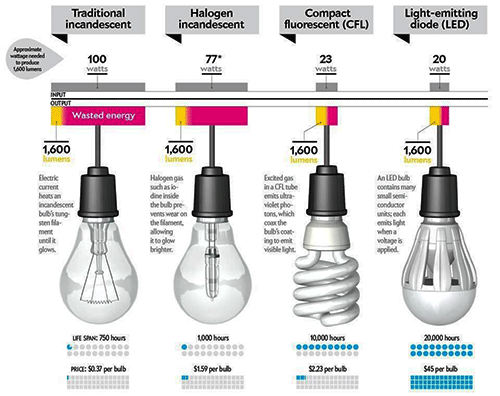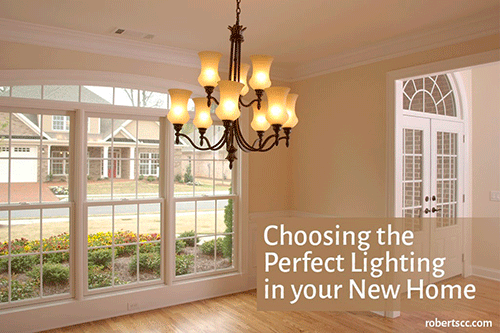We
generally use the terms 'lamp' or 'source' for all types of light-emitting
products used in light fixtures to produce the light we need. Every lamp has a
variety of characteristics that help determine its most appropriate application.
A variety of lamp types are available for residential applications. The most
common are incandescente, fluorescente and with light-emitting diodes (LEDs) (here).
The
above table is a quick reference of the most common lamp types, comparing their
energy use, colour rendering, life, and where they are typically used (here).
How
to choose light fixtures ?
In
many cases, a fixture is chosen simply because it looks attractive. However, if
it is very inefficient or does not direct the light where it is required, it is
not the best choice. Light fixtures allow us to control glare, direct light
where we want it and provide attractive aesthetics (here).
Important
detail when you are buying bulbs for your room is to observe the color
temperature of it. With unity expressed in Kelvin (K), the temperature of the
color corresponds to the apparent shade of light, which is popularly known as
white light and yellow light. Yellow light bulbs, or warmer ones, make the
surroundings more cozy and comfortable, stimulating the person to relax. For
this reason, they are indicated for living rooms and living areas in general (here). However, when you buy bulbs always consider
the lux and/or lumen values of each bulb as we saw in the previous post (here).
It
is useful to sort fixtures into the general type categories of Surface,
Pendant, Recessed, Track, Portable, Landscape and Fiber optic (here).
Surface mounted fixtures are
exposed, but remain close to – or flush with the ceiling or wall. They are
commonly used in hallways and bedrooms.
Pendant fixtures are suspended by a cord, chain, cable or other means and are
popular over tables, kitchens island and higher-ceiling areas (here).
Recessed lighting, usually in the form of downlights (or potlights), is typically found within a ceiling or wall cavity. Recessed lighting can be used in virtually every room in the home; however, it should not be used to provide all the layers of light required in a design (here).
Track lighting answers the need for flexibility in location, quantity and aiming angles. Track lighting has become much more sophisticated in function and appearance, with multiple circuits and voltages, finishes, colours and styles. It can be surface mounted on walls or ceilings or suspended (here).
Portable fixtures are defined typically by their cord, which can be plugged into any available electrical outlet. Desk and bed lights, floor lights, torchiers and some pictures lights fall into this category (here).
Landscape lighting refers to outdoor-rated fixtures. Theu are
generally used to accent trees, walkways and flower gardens and often includes
deck lighting (here).
Fiber optic lamps provide thin, clear fibers, which emit
colour-changing light out the ends. The fibers carry only light – no electricity
– so they are completely safe in any location (here).
There are many options.
Make a conscious choice.
In doubt consult an expert.
Brighten your home with joy.
Be happy.
See you!!!
Em português (in portuguese).
OPÇÕES DE ILUMINAÇÃO
Geralmente, usamos os
termos 'lâmpada' ou 'fonte' para todos os tipos de produtos emissores de luz
usados em luminárias para produzir a luz que precisamos. Todas as lâmpadas
possuem uma variedade de características que ajudam a determinar a sua
aplicação mais adequada. Diferentes tipos de lâmpadas estão disponíveis para
aplicações residenciais. Os mais comuns são incandescentes, fluorescentes e com
diodos emissores de luz (LEDs) (aqui).
A tabela acima é uma
referência rápida dos tipos de lâmpadas mais comuns, comparando seu uso de
energia, renderização de cores, vida e onde eles normalmente são usados.
Como escolher
luminárias?
Em muitos casos, uma
luminária é escolhida simplesmente porque parece atraente. No entanto, se for
ineficiente ou não dirigir a luz para onde é necessário, não será a melhor
escolha. As luminárias nos permitem controlar o brilho, a luz direta onde
queremos e oferecer uma estética atraente (aqui).
Detalhe importante
quando você for comprar lâmpadas para sua sala é observar a temperatura de cor
da mesma. Com unidade expressa em Kelvin (K), a temperatura da cor corresponde
à tonalidade aparente da luz, que popularmente é conhecida como luz branca e
luz amarela. As lâmpadas de luz amarela, ou mais quentes, tornam os ambientes
mais aconchegantes e confortáveis, estimulando a pessoa a relaxar. Por esta
razão, são indicadas para salas e áreas de estar em geral (aqui). Entretanto, quando você for comprar
lâmpadas considere sempre os valores de lux e/ou lúmen de cada lâmpada conforme
vimos na postagem anterior (aqui).
É útil classificar as
luminárias em tipos gerais de categorial: de Superfície, Pendente, Recesso,
Trilho, Portátil, Paisagem e Fibra óptica (aqui).
Superfície: As
luminárias montadas sobre uma superfície estão expostas, mas permanecem
próximas ou em recortes do teto ou da parede. Elas são muito usadas em corredores
e quartos.
Os acessórios Pendentes são
suspensos por uma corda, corrente, cabo ou outros meios e são utilizadas em
mesas, em ilhas de cozinhas e áreas de teto alto (aqui).
Iluminação Embutida, como diz o próprio nome, geralmente está embutida
em recorte feito no teto ou parede. A iluminação embutida pode ser usada
praticamente em todos os ambientes da casa; no entanto, não deve ser usado para
fornecer todas as camadas de luz necessárias em um projeto (aqui).
A iluminação com Trilho
atende a necessidade de flexibilidade de localização, quantidade e ângulos
alvo. A iluminação por trilhos tornou-se muito mais sofisticada em função e
aparência, com múltiplos circuitos e tensões, acabamentos, cores e estilos. Ela
pode ser montada sobre superfícies de paredes ou tetos ou ser suspensa (aqui).
As Luminárias Portáteis são
definidas tipicamente pelo seu cabo, o qual pode ser conectado a qualquer
tomada elétrica disponível. As luzes da mesa e de cama, luminárias de chão, os
tocheiros (candelabros) e algumas luzes para iluminar quadros se enquadram
nesta categoria (aqui).
A Iluminação de Paisagem
refere-se a acessórios para utilização ao ar livre. Geralmente são usados para
acentuar árvores, passarelas e jardins de flores e muitas vezes inclui
iluminação de decks (aqui).
As Lâmpadas de Fibra Óptica
fornecem fibras finas e claras que emitem luzes de diferentes cores para fora
de suas extremidades. As fibras carregam apenas luz - sem eletricidade – assim,
são completamente seguras em qualquer local (aqui).
As opções são
muitas.
Faça uma escolha
consciente.
Na dúvida consulte
um especialista.
Ilumine sua casa
com alegria.
Seja feliz.
Até a próxima.










